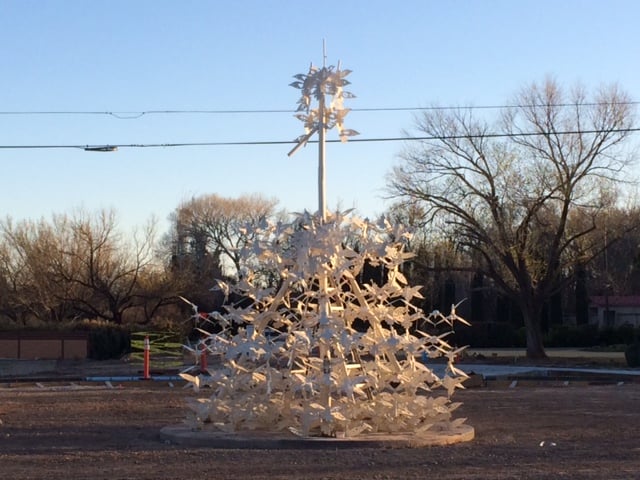Art World
Artist Margarita Cabrera Threatens El Paso with $500,000 Suit for Destruction of Public Sculpture
The sculpture incorporated guns donated by the local sheriff.

The sculpture incorporated guns donated by the local sheriff.

Brian Boucher

Margarita Cabrera is threatening the city of El Paso, Texas, with a half-million-dollar suit over a public sculpture she says the city has destroyed. The 40-foot sculpture was installed in March and then abruptly removed while she was out of town, says the artist’s lawyer, Francis S. Ainsa Jr., of El Paso firm Ainsa Hutson, in a letter to the city forwarded to artnet News.
“Her fondest wish is for the city to allow her to put the sculpture back,” Ainsa told artnet News today.
Her sculpture Uplift, commissioned in 2012, incorporates material from confiscated guns donated by the local sheriff and depicts a flock of birds taking flight as a symbol of transcending violence, according to the artist.
“Your final approved documents indicated that the metal shavings would be tossed into the concrete foundation but this is not the case you have significantly altered the design by adding actual guns to the work and compromised the structural integrity,” reads a run-on sentence in an email to the artist from the manager of the city’s public art program, Pat Dalbin, quoted by Ainsa. The email demanded that the artist cease and desist all work and report to Dalbin’s office the following Monday morning.
Ainsa says the artist obtained all required approvals and complied with her contract with the city, and that she has not yet been paid the full $70,000 she was due. The sculpture was to become city property only upon payment in full, says Ainsa, which means that the city destroyed work that belongs to the artist. He says that Cabrera has been unable to retrieve the work, which he values at $200,000.
Ainsa’s letter says that representatives of the city informed the artist that city manager Tommy Gonzalez ordered the removal of the work because the structure was unsound. The individuals who removed the sculpture will be individually liable, he threatens.
Hundreds of volunteers from both sides of the border helped to create the work, says Cabrera, ranging from school children and college students to local engineers.
A native of Monterrey, Mexico, Cabrera, 41, has a public work in the city of Austin, Texas, and has had solo shows at Dallas’ Talley Dunn Gallery, the El Paso Museum of Art, Los Angeles’ Walter Maciel Gallery, and New York’s Sara Meltzer Gallery, among others. Her CV indicates that she has been in group shows at institutions like the Smithsonian American Art Museum, Washington, DC; Socrates Sculpture Park, Long Island City, New York; the Los Angeles County Museum of Art; and the Contemporary Art Museum Houston. She earned a BFA and MFA at New York’s Hunter College.
According to the artist, quoted in Ainsa’s letter,
We invited the public from El Paso and Juarez to come together and create conversations about our violent histories here along our border community. The public encounters produced cultural symbols designs (sic) made by our community (using papel picado [perforated paper] traditions) that were subsequently transferred onto the wings of the birds. This creative process provided all of us who share this collective memory a sense of ownership, a newly bonded community, and a different, more intimate awareness of the challenges faced by our bi-national community with regard to violence.
In our border community of El Paso/Juarez, guns have contributed to our tragic history. We can attribute responsibility for death and injury to war, crime, drugs, corruption, and an insatiable quest for power.
“Legal issues aside, the manner in which the City Manager and the City staff have treated Ms. Cabrera is appalling,” Ainsa writes:
Even if there were a design issue, which is not the case, Ms. Cabrera is entitled to be treated with courtesy. Instead of engaging in a constructive discussion with her, the City essentially destroyed her artwork and severely damaged her reputation as a public artist.
Neither Mayor Oscar Leeser nor a representative of the city’s public art program immediately responded to requests for comment.
With a population of nearly 700,000, the city of El Paso is in far west Texas, directly across the border from Juárez, Mexico, which has been plagued by violence associated with the drug trade. El Paso’s public art program was established in 2006, according to its website, and requires that two percent from every capital improvement project budget go to the acquisition of public art. The city is home to projects by artists including Roberto Davidoff, Barbara Grygutis, Luis Jimenez and others. It added four projects in 2014, according to a brochure published on its site.
The city has damaged her reputation and prospects as a public artist, Ainsa told artnet News: “Other cities may back off from working with her because now she’s controversial.”
He added, “It’s going to be hard for the city to back out of this with any credibility.”